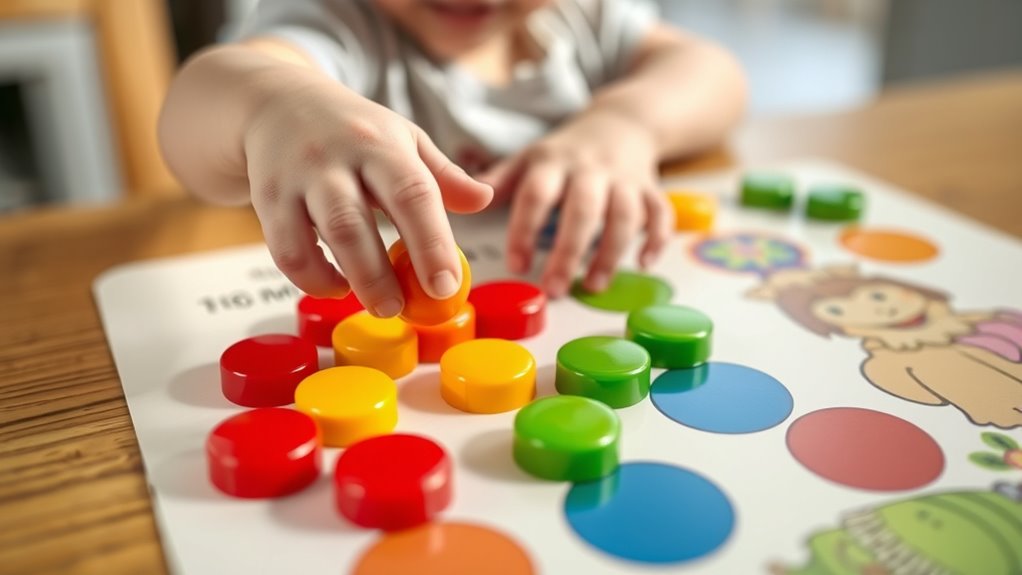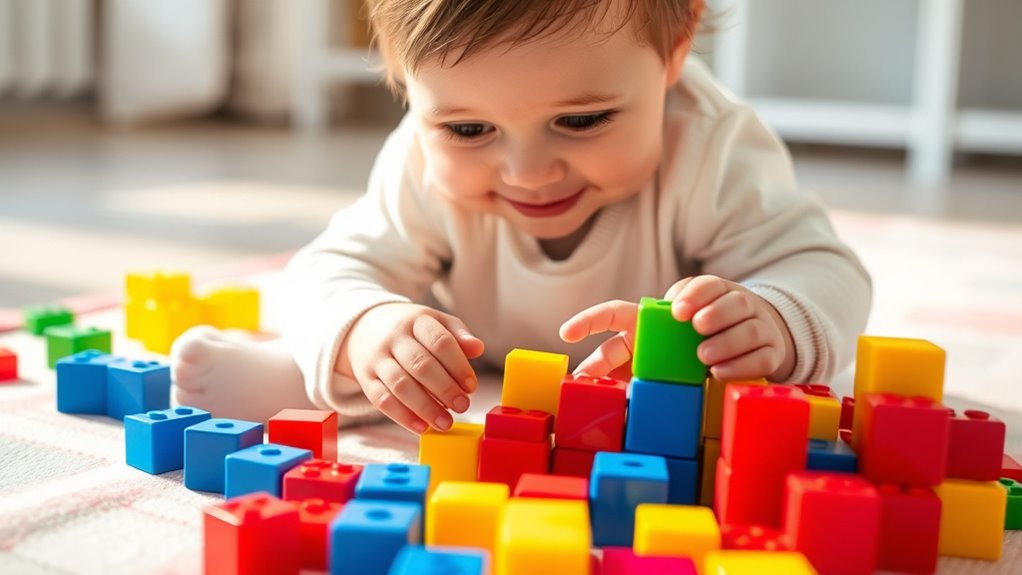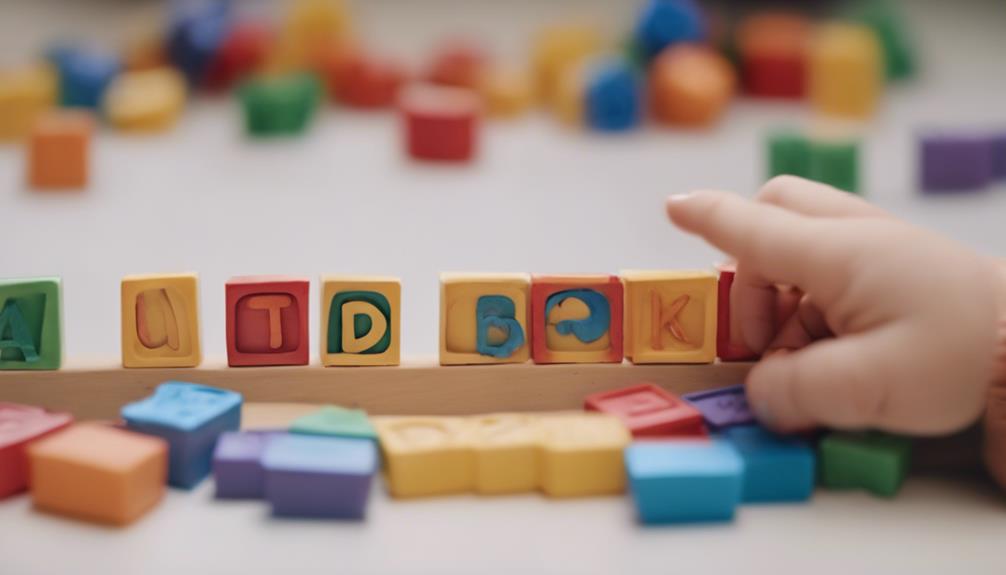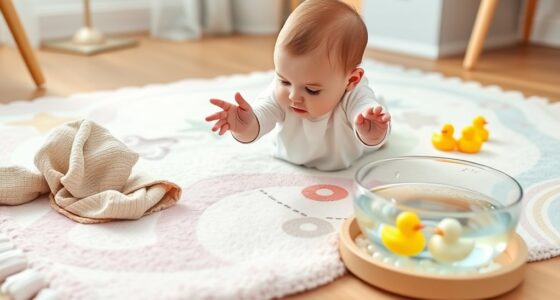To engage your 1-year-old in counting with colors, gather colorful objects like blocks or toys and arrange them within easy reach. Encourage your little one to pick up and sort items by color while naming each hue aloud. Focus on exploration and praise efforts to boost confidence. Gradually introduce sorting by size or shape as they progress. Keep activities fun and supportive, helping your child develop early counting and color recognition skills effortlessly. If you keep exploring, you’ll find more ways to make learning playful and effective.
Key Takeaways
- Use colorful objects to engage 1-year-olds in sorting activities that promote color recognition and early counting skills.
- Encourage children to pick up and sort objects by color, naming each color aloud for reinforcement.
- Keep activities simple, short, and playful to suit toddlers’ attention spans and developmental stage.
- Incorporate verbal cues and praise to motivate exploration and build positive associations with numbers and colors.
- Gradually introduce more variation, such as sorting by size or shape, to enhance cognitive and sensory development.

Have you ever thought about how colors can make counting more fun and engaging? Using colors in simple activities taps into your little one’s natural curiosity and encourages sensory play, which is crucial at this age. When you introduce colorful objects for counting, you not only help your child develop their understanding of numbers but also boost their color recognition skills. This approach makes learning feel like a game rather than a chore, fostering a positive attitude toward numbers and colors from the start.
Colors make counting fun, engaging, and help develop number understanding and color recognition through playful sensory activities.
For a straightforward activity, gather a variety of colorful objects—think of soft blocks, plastic counters, or even small toys in different hues. Spread them out where your child can easily reach them. As they explore, encourage them to pick up each item and place it into a designated container or on a mat. As they do this, name the colors aloud—”red,” “blue,” “yellow”—which reinforces their color recognition and helps them associate colors with the objects. This process turns a simple sorting activity into a multisensory experience, engaging their sight, touch, and even sound if you include verbal cues.
To make it more engaging, you can set a small goal, like counting how many red objects they can find or encouraging them to sort objects by color. For example, ask, “Can you find all the yellow blocks?” or “Let’s count how many blue cups you have.” Keep your tone lively and supportive, and praise every effort. This not only encourages participation but also fosters their confidence in their developing skills. Remember, at this age, the focus isn’t on perfect accuracy but on exploration and discovery. Your enthusiasm helps turn this activity into a fun adventure, where your child learns through play.
As your child becomes more comfortable with the activity, you can introduce variations, such as sorting by size or shape alongside color. This not only makes the activity richer but also helps build their categorization skills. Keep the activity short and frequent—young children have limited attention spans—so they stay interested and excited for the next round. Throughout, your role is to guide gently, celebrate their successes, and encourage curiosity. By combining sensory play with these simple counting and sorting tasks, you create an enriching environment that promotes both cognitive and sensory development. Additionally, understanding that trust issues often develop from experiences like parental infidelity can help caregivers foster a secure environment for their children. Overall, using colors to teach counting is a delightful, effective way to introduce your little one to numbers, colors, and the joy of learning through play.
Frequently Asked Questions
What Are the Best Colors to Start With for Toddlers?
When introducing colors to toddlers, start with bright, high-contrast shades like red, yellow, blue, and green. These colors help boost their color recognition skills and support developmental milestones. You should choose simple, vivid colors that capture their attention and make learning fun. By focusing on these primary colors, you set a strong foundation for their understanding of colors and encourage active engagement in early learning activities.
How Long Should a Sorting Activity Last for a 1-Year-Old?
While a 1-year-old’s attention span is brief, aim for a duration of about 5 to 10 minutes for a sorting activity. This balance keeps their engagement high without causing frustration. Use engagement tips like offering praise and switching activities if interest wanes. Remember, short, playful sessions foster learning and enjoyment, helping your child develop early sorting skills while keeping the experience fun and lively.
Can This Activity Help With Fine Motor Skills Development?
Yes, this activity can boost your child’s fine motor skills by encouraging hand-eye coordination and tactile exploration. As they pick up and sort colorful objects, they practice grasping, pinching, and releasing, which strengthens their hand muscles. The engaging colors and textures also stimulate their senses, helping develop their tactile exploration. Over time, these actions support better coordination and dexterity essential for future writing and other fine motor tasks.
How Do I Encourage a Reluctant Child to Participate?
Research shows positive reinforcement boosts children’s engagement. To encourage a reluctant child, try engaging storytelling to make the activity more enthralling, and celebrate small successes with praise. Show enthusiasm yourself and keep activities short and fun, so they don’t feel overwhelmed. Over time, consistent encouragement and creating a playful atmosphere will help your child feel more comfortable and enthusiastic to participate, making learning enjoyable for both of you.
Are There Any Safety Concerns With Using Small Colored Objects?
When using small colored objects, you should always consider safety concerns like choking hazards. Always choose items made from non-toxic materials to guarantee your child’s safety. Never leave them unattended with small objects, and regularly inspect toys for damage or loose parts. Keep an eye on your little one during activities, and choose age-appropriate items to minimize risks. Your vigilance helps create a safe, fun learning environment.
Conclusion
As you introduce colors and counting to your little one, remember you’re planting seeds that will grow into a world of learning adventures. Think of this activity as a gentle ripple in a pond—each small step creating waves of understanding. Keep it fun and simple, and watch as your child’s curiosity blossoms like a garden in spring. With patience and play, you’re turning everyday moments into colorful milestones they’ll cherish forever.










